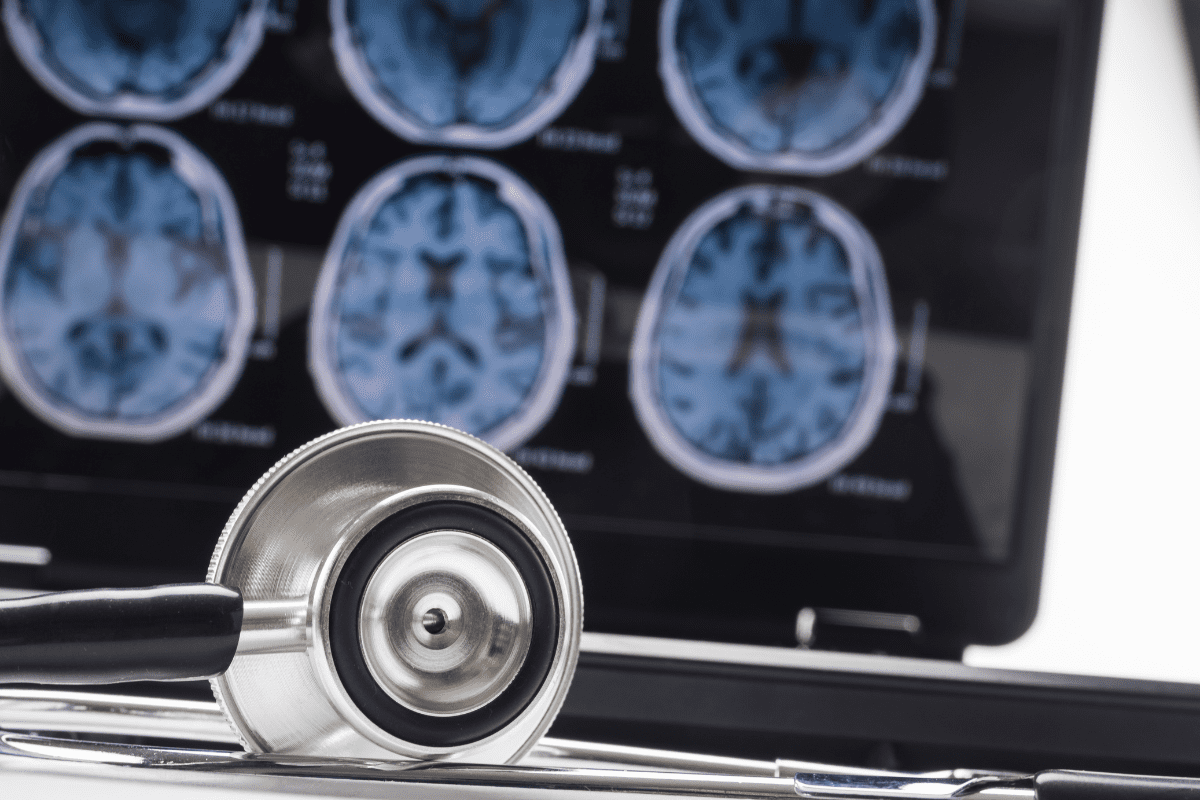
What’s worse than tapeworms in our intestine? Tapeworm larval cysts that move into our organs, eyes and central nervous system. When present in the central nervous system, they appear as lesions and cause virtually any symptom found in any neurological disease, including MS.
This post explores the findings of Dr. Alan MacDonald and how his groundbreaking research helps us to understand the cause of multiple sclerosis and brings us much closer to a cure.
In Dr. Alan MacDonald’s 2021 study, “Novel Brain Compartment Tapeworm Larvae-Possible Environmental Initiators of Demyelination in Multiple Sclerosis,” he reported his discovery of tapeworm larval cysts in the central nervous system of every MS subject tested.[i]
These cysts in the central nervous system (CNS) of animals cause demyelinating disease. These are not the only parasites that Dr. MacDonald discovered in MS, but they are probably one of the most relevant.
Neurocysticercosis
Neurocysticercosis (NCC) is a disease caused by an infection of tapeworm larval cysts in the central nervous system. It is a significant illness that causes disability and in severe cases death.
Although it is believed that NCC in humans is caused mostly by the pork tapeworm, other tapeworm species can produce cystic larvae that invade the central nervous system. In addition, Dr. MacDonald’s research suggests that several different species of tapeworm larvae cysts were likely present in the subjects he tested.
Tapeworm larval cysts are sacs that contain the immature larval stage of the tapeworm.[ii] NCC is regarded as the great imitator because the symptoms it causes mimic almost any neurological disorder. The disease severity and symptoms of NCC are the result of the number, size, and location of cysts and intensity of the immune response to the cysts.[iii]
Neurocysticercosis may be parenchymal (in the brain tissue), or extraparenchymal (in the spaces in the brain or spinal cord where cerebrospinal fluid flows).[iv]
NCC is the most common central nervous system parasitic infection in humans and the most common cause of epilepsy. It is a neglected disease that is preventable.
How people get neurocysticercosis?
1. By becoming infected with tapeworm eggs through:
- Eating contaminated fruit and vegetables
- Drinking contaminated water
- Self-infection – poor hygiene. Some patients are infected with both the larval cysts and adult tapeworms, and it is possible for a tapeworm-carrying individual to develop the larval cysts by autoinfection.
- Animals – pets, livestock
- Poor hygiene of people infected with tapeworms that prepare food (ex. restaurants).
2. By first becoming infected with the larval cysts when eating raw or undercooked meat contaminated with larval cysts.
Tapeworm eggs from the environment are swallowed and hatch in the small intestine to release oncospheres (immature or tapeworm larva).
Oncospheres either develop into cystic larvae, attach to the lining of the small intestine and mature into an adult worms,[v] or the cystic larvae move into various muscle, skin, eyes, organs and the central nervous system.
Adult tapeworms can grow up to 8 m in length (depending on the species) and may survive in the small intestines for 10 to 20 years.
Neurocysticercosis symptoms
Depending on where the cysts are located in the central nervous system, their size and the number of cysts, NCC symptoms can include:
- Headache
- Blindness
- Dementia
- Meningitis
- Seizures
- Depression
- Cognitive dysfunction
- Dizziness
- Poor balance
- Poor coordination
- Difficulty walking and falls
- Nerve pain in the spine or limbs
- Muscle weakness
- Muscle twitches or spasms
- Muscle paralysis
- Changes in thinking or behaviors – confusion or loss of consciousness for even a moment
- Hallucination
- Tinnitus, hearing loss
- Loss of taste or smell
- Nystagmus – involuntary, rapid and repetitive movement of the eyes
- Facial nerve palsy
- Trigeminal neuralgia
- Pain that radiates from the back and hip into the legs through the spine.
How Neurocysticercosis is Diagnosis
1. Patient health history – their symptoms, diagnoses of other conditions and risk factors for exposure to tapeworms.
2. A stool test to detect tapeworm eggs or proglottids (segments of tapeworms).
3. Energy testing to determine what parasite drugs test well for a patient – Autonomic Response Testing (ART), Acupuncture Meridian Assessment (AMA), Vega testing, Applied kinesiology, Electrodermal screening (EAV). Does the patient’s energy test well for tapeworm parasite medications?
4. Central nervous system imaging –MRI and CT scans.
5. Serological testing (antibody blood test). The enzyme-linked immunoelectrotransfer blot or EITB (preferred by the CDC), and commercial enzyme-linked immunoassays are the two tests available.
Factors to consider:
The antibody test result may be negative even if a patient has one or more tapeworm cysts and lesions visible with imaging.
Larval cysts may be present in areas outside the brain (ex. the spinal cord), where imaging may be negative but antibody test results might be positive
According to the CDC, the location and characteristics of the lesions on imaging, especially on MRI, are essential to determine the best treatment plan.[vi]
Neurocysticercosis Treatments
**Always do an eye exam before starting treatment. If one or more larval cysts are present in the eye, they must be surgically removed or the parasite drug treatment may severely damage the eye.
The distinction between larval cysts in the brain versus in the spinal fluid must be determined.
A small number of larval cysts in the brain results in an excellent long-term prognosis.[vii]
Because parasite drug therapy that kills the larval cysts can cause a strong immune response and make symptoms worse, it is advised to prescribe a steroid that crosses the blood brain barrier (for ex. dexamethasone) to mitigate a die-off effect.
Although trials show that parasite drug albendazole can decrease the frequency of seizures, it has not been effective enough on its own to always eradicate larval cysts in all patients.
Studies show that prescribing a combination of albendazole and praziquantel for an adequate length of time is more effective at eradicating tapeworm larval cysts that cause neurocysticercosis.
CDC general guidelines for NCC treatment:
- Parasite drug therapy is helpful for patients who have symptoms and several live (noncalcified) tapeworm larval cysts.
- Parasite drug treatment will not benefit patients with dead worms (calcified cysts).
- It’s recommended to administer steroids (ex. dexamethasone) to suppress the inflammatory response brought on by the destruction of live larval cysts.
- Anti-seizure medication is given to manage seizure disorders caused by NCC.
- Intraventricular cysts should usually be removed surgically (endoscopically if possible). The use of parasite drugs may cause an inflammatory response that could cause a blockage of spinal fluid.
- Treatment with both anthelminthics and corticosteroids is usually required. Ventricular shunting may also be necessary.[viii]
Surgical removal of tapeworm larval cysts:
Although most cases of NCC can be treated successfully by a combination of parasite drug treatments, severe cases may require surgery.
The following videos show how tapeworm larval cysts are surgically removed from the CNS. You can find more videos like this on YouTube. Caution – this content is graphic.
Videos:
Surgical Management of Racemose Neurocysticercosis
Cysticercosis of the Cranial Base.
There are at least six significant reasons why tapeworm larval cysts in the central nervous system may be one of the main parasites that cause multiple sclerosis:
1. Dr. Alan McDonald found tapeworm larval cysts in the spinal fluid of 100% of the MS subjects tested.
2. Tapeworm larval cysts in animals cause a brain demyelination disease.
3. Tapeworm larval cysts appear as lesions on MRI scans.
4. Neurocysticercosis and multiple sclerosis share many of the same symptoms.
5. The criteria for diagnosing multiple sclerosis requires that there must be a dissemination of lesions in space and time, meaning lesions must spread into different areas in the central nervous system overtime.[ix]
Tapeworm larval cysts (cysticerci) in the central nervous system can also disseminate or spread to other parts of the CNS over time.[x]
6. When diagnosing MS, the lesions are considered active (symptomatic) or not active (asymptomatic).[xi]
In neurocysticercosis, the lesions which are tapeworm larval cysts (cysticerci) in the CNS show as either live tapeworm larval cysts (non-calcified) or dead tapeworm larval cysts (calcified).[xii]
Where do we go from here?
It is vital that Dr. Alan McDonald’s findings are studied further but it is very odd and disturbing that the panel of medical professionals that decide how MS is diagnosed and treated (Diagnosis of multiple sclerosis: 2017 revisions of the McDonald criteria), declare that there is no value in looking at the spinal fluid of MS patients for possible parasitic infections. This group is generously financially supported by the very companies that sell and profit from the drugs that treat MS (Diagnosis of multiple sclerosis: 2017 revisions of the McDonald criteria, Declaration of interests page 170).
It’s also important to consider that other parasites can also cause lesions in the central nervous system, thus for treatment purposes and successful recovery, it’s important to identify which parasites are living in the central nervous system.
Please share this information with health care professionals and health advocate groups especially on social media. It is likely that neurocysticercosis impacts many people and early treatment is vital to prevent disease in the future.
There are real solutions to recover from parasites today!
To restore health, we must focus on treating the cause of inflammation, which are parasites. First, identify the enemy (parasites), then support the body and treat the parasites while following a holistic approach. When parasitic infections are treated effectively, we can overcome inflammation or disease.
If you’re frustrated with the fact that our standard of care STILL doesn’t offer a real solution for treating MS and other diseases, then click on the link below to watch Pam Bartha’s free masterclass training and discover REAL solutions that have allowed Pam and many others to live free from MS and other diseases.
CLICK Here to watch Pam’s masterclass training
References:
[ii] https://www.cdc.gov/parasites/resources/pdf/npis_in_us_neurocysticercosis.pdf
[iii] https://www.ncbi.nlm.nih.gov/pmc/articles/PMC6108081/#R38
[iv] https://www.cdc.gov/parasites/cysticercosis/health_professionals/index.html
[vi] https://www.cdc.gov/parasites/cysticercosis/health_professionals/index.html
[vii] https://www.cdc.gov/parasites/cysticercosis/health_professionals/index.html
[viii] https://www.cdc.gov/parasites/cysticercosis/health_professionals/index.html
[xii] https://www.cdc.gov/parasites/cysticercosis/health_professionals/index.html

Clinically diagnosed with multiple sclerosis at the age of 28, Pam chose an alternative approach to recovery. Now decades later and still symptom free, she coaches others on how to treat the root cause of chronic disease, using a holistic approach. She can teach you how, too.
Pam is the author of Become a Wellness Champion and founder of Live Disease Free. She is a wellness expert, coach and speaker.
The Live Disease Free Academy has helped hundreds of Wellness Champions in over 15 countries take charge of their health and experience profound improvements in their life.

